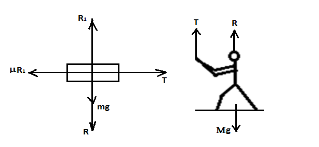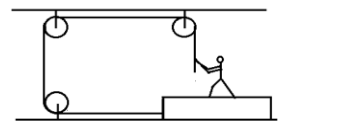Answer
414.9k+ views
Hint: To solve the above problem we will have to prepare a free body diagram to understand all forces that are acting on the body. After that we will balance the forces which are acting in the opposite direction then we will find the unknown quantity that is asked in the question.
Complete answer:
So, the free body diagram showing all the forces on the man and the plank is as follows,

So, from the free body diagram we see that the man is experiencing three forces and balancing the forces in the opposite direction we will have the following equation,
$T + R = Mg$
$ \Rightarrow R = Mg - T$-----equation (1)
Now on seeing the free body diagram of the plank, balancing the vertical forces,
In vertical upward direction the normal reaction force ${R_1}$ and in the vertical downward direction mass of the plank$mg$and the other normal reaction force $R$is acting.
${R_1} = mg + R$
$ \Rightarrow {R_1} = R + mg$--------equation (2)
In the horizontal direction the force on the left horizontal is friction force $\mu {R_1}$and the force in the right horizontal direction is the tension in the rope $T$.
So, $T = \mu {R_1}$------equation (3)
Now, Putting the value of the ${R_1}$from the equation (2), we get
$ \Rightarrow T = \mu (R + mg)$
$ \Rightarrow T = \mu R + \mu mg$
$ \Rightarrow T = \mu (Mg - T) + \mu mg$
$ \Rightarrow T = \mu Mg - \mu T + \mu mg$
$ \Rightarrow T + \mu T = \mu Mg + \mu mg$
$ \Rightarrow T(1 + \mu ) = \mu (Mg + mg)$
$ \Rightarrow T = \dfrac{{\mu (Mg + mg)}}{{(1 + \mu )}}$
Hence, the maximum force that the man can exert on the rope is $\dfrac{{\mu (Mg + mg)}}{{(1 + \mu )}}$.
So, the correct answer is “Option D”.
Note:
Here we have taken the help of the free body diagram so we should know the appropriate definition of the free body diagram. Free-body diagrams are diagrams used to show the relative magnitude and direction of all forces acting upon an object in a given situation. Sometimes it is called a force diagram since it shows the proper position and direction of the forces.
Complete answer:
So, the free body diagram showing all the forces on the man and the plank is as follows,

So, from the free body diagram we see that the man is experiencing three forces and balancing the forces in the opposite direction we will have the following equation,
$T + R = Mg$
$ \Rightarrow R = Mg - T$-----equation (1)
Now on seeing the free body diagram of the plank, balancing the vertical forces,
In vertical upward direction the normal reaction force ${R_1}$ and in the vertical downward direction mass of the plank$mg$and the other normal reaction force $R$is acting.
${R_1} = mg + R$
$ \Rightarrow {R_1} = R + mg$--------equation (2)
In the horizontal direction the force on the left horizontal is friction force $\mu {R_1}$and the force in the right horizontal direction is the tension in the rope $T$.
So, $T = \mu {R_1}$------equation (3)
Now, Putting the value of the ${R_1}$from the equation (2), we get
$ \Rightarrow T = \mu (R + mg)$
$ \Rightarrow T = \mu R + \mu mg$
$ \Rightarrow T = \mu (Mg - T) + \mu mg$
$ \Rightarrow T = \mu Mg - \mu T + \mu mg$
$ \Rightarrow T + \mu T = \mu Mg + \mu mg$
$ \Rightarrow T(1 + \mu ) = \mu (Mg + mg)$
$ \Rightarrow T = \dfrac{{\mu (Mg + mg)}}{{(1 + \mu )}}$
Hence, the maximum force that the man can exert on the rope is $\dfrac{{\mu (Mg + mg)}}{{(1 + \mu )}}$.
So, the correct answer is “Option D”.
Note:
Here we have taken the help of the free body diagram so we should know the appropriate definition of the free body diagram. Free-body diagrams are diagrams used to show the relative magnitude and direction of all forces acting upon an object in a given situation. Sometimes it is called a force diagram since it shows the proper position and direction of the forces.
Recently Updated Pages
How many sigma and pi bonds are present in HCequiv class 11 chemistry CBSE

Why Are Noble Gases NonReactive class 11 chemistry CBSE

Let X and Y be the sets of all positive divisors of class 11 maths CBSE

Let x and y be 2 real numbers which satisfy the equations class 11 maths CBSE

Let x 4log 2sqrt 9k 1 + 7 and y dfrac132log 2sqrt5 class 11 maths CBSE

Let x22ax+b20 and x22bx+a20 be two equations Then the class 11 maths CBSE

Trending doubts
Fill the blanks with the suitable prepositions 1 The class 9 english CBSE

At which age domestication of animals started A Neolithic class 11 social science CBSE

Which are the Top 10 Largest Countries of the World?

Give 10 examples for herbs , shrubs , climbers , creepers

Difference between Prokaryotic cell and Eukaryotic class 11 biology CBSE

Difference Between Plant Cell and Animal Cell

Write a letter to the principal requesting him to grant class 10 english CBSE

Change the following sentences into negative and interrogative class 10 english CBSE

Fill in the blanks A 1 lakh ten thousand B 1 million class 9 maths CBSE




